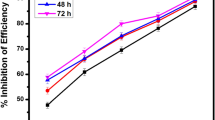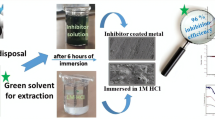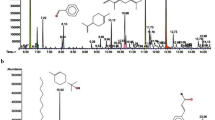Abstract
A study on the use of methanolic extract of Thymus vulgaris leaves as green corrosion inhibitor for bronze in simulated acid rain has been carried out using gravimetric and electrochemical tests. Electrochemical tests included potentiodynamic polarization curves and electrochemical impedance spectroscopy. Inhibitor concentrations were in the range 0–1000 ppm, whereas testing temperatures included 25, 40 and 60 °C. The results indicate that T. vulgaris is a good, anodic type of inhibitor with an efficiency that increased with the inhibitor concentration, reaching its maximum value, higher than 90%, at a concentration of 800 ppm, but it decreased as the temperature increased from 25 down to 60 °C. The inhibitor is physically adsorbed onto the metal surface according to a Langmuir adsorption isotherm at the different testing temperatures. The extract contains many antioxidants being the most abundant ones phenol, 2-metil-5-(1-metilethyl)- and d, α-tocopherol which give to the extract its inhibitory properties.










Similar content being viewed by others
Data Availability
Data will be available on reasonable request.
References
Chang T, Herting G, Goidanich S, Sánchez Amaya JM, Arenas MA, Le Bozec N, Leygra I, Odnevall Wallinder I (2019) The role of Sn on the long-term atmospheric corrosion of binary Cu-Sn bronze alloys in architecture. Corros Sci 149:54–67. https://doi.org/10.1016/j.corsci.2019.01.002
Liang Z, Jiang K, Zhang T, Dou Z (2019) Corrosion behavior of Cu–Sn bronze alloys in simulated archeological soil media. Mater Corros 71:617–627. https://doi.org/10.1002/maco.201911338
Petiti C, Toniolo L, Gulotta D, Mariani B, Goidanich S (2020) Effects of cleaning procedures on the long-term corrosion behavior of bronze artifacts of the cultural heritage in outdoor environment. Environ Sci Pollut Res 27:3081–13094. https://doi.org/10.1007/s11356-020-07814-4
Chang T, Maltseva A, Volovitch P, Odnevall Wallinder I, Leygraf C (2020) A mechanistic study of stratified patina evolution on Sn-bronze in chloride-rich atmospheres. Corros Sci 166:108477. https://doi.org/10.1016/j.corsci.2020.108477
Liu Z, Yang J, Zhang J, Xiang H, Wei H (2019) A bibliometric analysis of research on acid rain. Sustainability 1:3077–3084. https://doi.org/10.3390/su11113077
Szilvia S, Nagy M, Juhász L, Bubonyi T, Péter B, Forgács G, Bakonyi E (2020) Conservation purpose material testing of corrosion products on outdoor bronze statues. IOP Conf Ser: Mater Sci Eng 903:012037–012044. https://doi.org/10.1088/1757-899X/903/1/012037
Letardi P (2021) Testing new coatings for outdoor bronze monuments: a methodological overview. Coatings 11:131–140. https://doi.org/10.3390/coatings11020131
Abdel-Karim AM, El-Shamy AM (2022) A review on green corrosion inhibitors for protection of archeological metal artifacts. J Bio Tribo Corros. https://doi.org/10.1007/s40735-022-00636-6
Marzorati S, Verotta L, Trasatti SP (2019) Green corrosion inhibitors from natural sources and biomass wastes. Molecules 24:48–57. https://doi.org/10.3390/molecules24010048
Miralrio A, Espinoza Vázquez A (2020) Plant extracts as green corrosion inhibitors for different metal surfaces and corrosive media: a review. Processes 8:942–953. https://doi.org/10.3390/pr8080942
Popoola LT (2020) Progress on pharmaceutical drugs, plant extracts and ionic liquids as corrosion inhibitors. Heliyon 5:01143–01152. https://doi.org/10.1016/j.heliyon.2019.e01143
Singh CD, Verma C, Quraishi MA (2021) Molecular structural aspects of organic corrosion inhibitors: experimental and computational insights. J Mol Struct 1227:129374. https://doi.org/10.1016/j.molstruc.2020.129374
Sharma S, Kumar A (2021) Recent advances in metallic corrosion inhibition: a review. J Mol Liq 322:114862. https://doi.org/10.1016/j.molliq.2020.114862
Binyehmed FM, Abdullah AM, Zainal Z, Zawawi RM (2018) Green coffee bean extract as a green corrosion inhibitor for aluminium in artificial acid rain medium. Int J Appl Environ 13:171–183
Abbout S, Chellouli M, Zouarhi M, Benzidia B, Hammouch H, Chebabe D, Dermaj A, Erramli H, Bettach N, Hajjaji N (2018) New formulation based on Ceratonia siliqua L. Seed oil, as a green corrosion inhibitor of iron in acidic medium. Anal Bioanal Electrochem 10:789–804
Pilić Z, Martinović I (2019) Effect of Helichrysum italicum on the corrosion of copper in simulated acid rain solution. Chem Biochem Eng Q 33:449–457. https://doi.org/10.15255/CABEQ.2019.1614
Varvara S, Caniglia G, Izquierdo J, Bostan R, Găină L, Bobis O, Souto RM (2020) Multiscale electrochemical analysis of the corrosion control of bronze in simulated acid rain by horse-chestnut (Aesculus hippocastanum L.) extract as green inhibitor. Corros Sci 165:108381. https://doi.org/10.1016/j.corsci.2019.108381
Rehioui M, Abbout S, Benzidia B, Hammouch H, Erramli H, Daoud NA, Badrane N, Hajjaji N (2021) Corrosion inhibiting effect of a green formulation based on Opuntia dillenii seed oil for iron in acid rain solution. Heliyon 7:06674–06682. https://doi.org/10.1016/j.heliyon.2021.e06674
Chraka A, Raissouni I, Ben SN, Khayar S, Mansour A, Tazi S, Chaouket F, Bouchta D (2020) Identification of potential green inhibitors extracted from Thymbra capitata (L.) Cav. for the corrosion of Brass in 3% NaCl solution: experimental, SEM–EDX analysis, DFT computation and Monte Carlo simulation studies. J Bio Tribo Corros 6:80–99. https://doi.org/10.1007/s40735-020-00377-4
Fouda AS, Shalabi K, Idress AA (2015) Ceratonia siliqua extract as a green corrosion inhibitor for copper and brass in nitric acid solutions. Green Chem Lett Rev 8:17–29. https://doi.org/10.1080/17518253.2015.1073797
Benzidia B, Hammouch H, Dermaj A, Benassaoui H, About S, Hajjaji N (2019) Investigation of green corrosion inhibitor based on Aloe vera (L.) Burm. F. for the protection of bronze B66 in 3% NaCl. Anal Bioanal Electrochem 11:165–177
Abdel-Karim AM, El-Shamy AM (2022) A review on green corrosion inhibitors for protection of archeological metal artifacts. J Bio Tribo Corros 8:35–43. https://doi.org/10.1007/s40735-022-00636-6
Tasić ŽZ, Petrović Mihajlović MB, Radovanović MB, Simonović AT, Antonijević MM (2020) Experimental and theoretical studies of paracetamol as a copper corrosion inhibitor. J Mol Liq. https://doi.org/10.1016/j.molliq.2020.114817
Tasić ŽZ, Petrović Mihajlović MB, Radovanović MB, Simonović AT, Antonijević MM (2019) Ibuprofen as a corrosion inhibitor for copper in synthetic acid rain solution. Sci Rep 9:14710. https://doi.org/10.1038/s41598-019-51299-2
Biswal J, Pant HJ, Sharma VK, Sharma SC, Gupta AK (2021) Evaluation of inhibition effect of poly vinyl pyrrolidone on corrosion of bronze in simulated acid rain using thin layer activation technique. Nucl Inst Methods Phys Res B 503:30–36. https://doi.org/10.1016/j.nimb.2021.07.007
Khan A, Amjad M, Saboon S (2019) GC-MS analysis and biological activities of Thymus vulgaris and Mentha arvensis essential oil. Turk J Biochem 44:388–396. https://doi.org/10.1515/tjb-2018-0258
Escobar A, Perez M, Romanelli G, Blustein G (2020) Thymol bioactivity: a review focusing on practical applications. Arab J Chem 13:9243–9269. https://doi.org/10.1016/j.arabjc.2020.11.009
Jannati N, Honarvar M, Gharachorloo M (2021) Extraction of thymol compound from Thymus vulgaris L. oil. JMPB 1:81–84. https://doi.org/10.22092/JMPB.2020.351668.1252
Gedikoğlu A, Sökmen M, Çivit A (2019) Evaluation of Thymus vulgaris and Thymbra spicata essential oils and plant extracts for chemical composition, antioxidant, and antimicrobial properties. Food Sci Nutr 7:1704–1714. https://doi.org/10.1002/fsn3.1007
Sas IT, Proks M, Păunescu V, Pînzaru I, Sas I, Coricovac D, Moacă A, Dehelean C (2019) Thymus vulgaris extract formulated as cyclodextrin complexes: synthesis, characterization, antioxidant activity and in vitro cytotoxicity assessment. Farmacia 67:442–451. https://doi.org/10.31925/farmacia.2019.3.10
Hemmati S, Joshani Z, Zangeneh A, Zangeneh M (2019) Green synthesis and chemical characterization of Thymus vulgaris leaf aqueous extract conjugated gold nanoparticles for the treatment of acute myeloid leukemia in comparison to doxorubicin in a leukemic mouse model. Appl Organomet Chem 34:5267. https://doi.org/10.1002/aoc.5267
Crespo Y, Sánchez L, Sol A, García-Quintana Y (2019) Evaluation of the synergistic effects of antioxidant activity on mixtures of the essential oil from Apium graveolens L., Thymus vulgaris L. and Coriandrum sativum L. using simplex-lattice design. Heliyon 5:01942. https://doi.org/10.1016/j.heliyon.2019.e01942
Abdelbassat H, Bouhlali EDT, Khouya T, Ramchoun M, Zegzouti Y, Alem C, Benlyas M (2019) Antioxidant, anti-inflammatory and anticoagulant activities of three Thymus species grown in southeastern Morocco. Future J Pharm Sci 5:4–11. https://doi.org/10.1186/s43094-019-0005-x
Afonso AF, Pereira OR, Cardoso SM (2020) Health-promoting effects of thymus phenolic-rich extracts: antioxidant, anti-inflammatory and antitumoral properties. Antioxidants 9:814–822. https://doi.org/10.3390/antiox9090814
ASTM G1-03 (2017) Standard practice for preparing, cleaning and evaluating corrosion test specimens, ASTM International, WestConshohocken
Fuchs-Godec R, Zerjav G (2015) Corrosion resistance of high -level-hydrophobic layers in com bination with Vitam in E—(a-tocopherol) as green inhibitor. Corros Sci 97:7–16. https://doi.org/10.1016/j.corsci.2015.03.016
Verma DK, Khan F (2016) Green approach to corrosion inhibition of mild steel in hydrochloric acid medium using extract of spirogyra algae. Green Chem Lett Rev 9:52–60. https://doi.org/10.1080/17518253.2015.1137976
Ngobiri NC, Oguzie EE, Li Y (2015) Eco-friendly corrosion inhibition of pipeline steel using Brassica oleracea. Int J Corros 2015:1–9. https://doi.org/10.1155/2015/404139
Yaqo EA, Anee RA, Abdulmajeed MH, Tomi IHR, Kadhim MM (2019) Aminotriazole derivative as anti-corrosion material for Iraqi kerosene tanks: electrochemical, computational and the surface study. Chem Select 4:9883–9892. https://doi.org/10.1002/slct.201902398
Alkarim TA, Al-Azawi KF, Anee RA (2021) Anticorrosive properties of Spiramycin for aluminum in acidic medium. Int J Corros Scale Inhib 10:1168–1188. https://doi.org/10.17675/2305-6894-2021-10-3-20
Bentiss F, Bouanis M, Mernari B, Traisnel M, Vezin H, Lagrenee M (2007) Understanding the adsorption of 4H–1,2,4-triazole derivatives on mild steel surface in molar hydrochloric acid. Appl Surf Sci 253:3696–3704. https://doi.org/10.1016/j.corsci.2012.03.036
Free ML (2002) Understanding the effect of surfactant aggregation on corrosion inhibition of mild steel in acid medium. Corros Sci 44:2865–2870. https://doi.org/10.1016/S0010-938X(02)00080-X
Mareci D, Chelariu R, Rusu I, Melniciuc Puică N, Sutiman D (2010) Electrochemical behaviour of some religious artefacts in simulated acid rain. Eur J Sci 6:57–70
El Adnani Z, Mcharfi M, Sfaira M, Benzakour M, Benjelloun AT, Touhami ME (2013) DFT theoretical study of 7-R-3methylquinoxalin-2 (1H)-thiones (R=H; CH3; Cl) as corrosion inhibitors in hydrochloric acid. Corros Sci 68:223–230. https://doi.org/10.1016/j.corsci.2012.11.020
Funding
The authors declare that no funds, grants, or other support were received during the preparation of this manuscript.
Author information
Authors and Affiliations
Contributions
All authors contributed to the study conception and design. Material preparation, data collection and analysis were performed by DGG-G, AKL-G and RL-S. The first draft of the manuscript was written by JGG-R and all authors commented on previous versions of the manuscript. All authors read and approved the final manuscript.
Corresponding author
Ethics declarations
Conflict of interest
The authors have no relevant financial or non-financial interests to disclose.
Additional information
Publisher's Note
Springer Nature remains neutral with regard to jurisdictional claims in published maps and institutional affiliations.
Rights and permissions
About this article
Cite this article
Gonzalez-Rodriguez, J.G., Gutierrez-Granda, D.G., Larios-Galvez, A.K. et al. Use of Thymus vulgaris Extract as Green Corrosion Inhibitor for Bronze in Acid Rain. J Bio Tribo Corros 8, 77 (2022). https://doi.org/10.1007/s40735-022-00676-y
Received:
Revised:
Accepted:
Published:
DOI: https://doi.org/10.1007/s40735-022-00676-y




